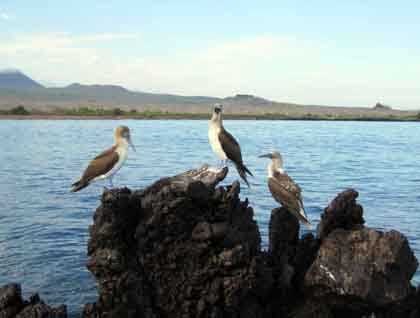Located in the south East of the archipelago, Floreana received its name in honor to the first President of Ecuador, General Juan Jose Flores. It was visited by Charles Darwin and much earlier it was a hideout of pirates and buccaneers who used the island as a mandatory place for the resupplying of water and giant tortoises, diminishing the number of those emblematic creatures to extinction.
Early in the morning we headed to Punta Cormorant with its green beaches dotted with sea turtle tracks. Along the bushes some pelicans rested, attentively watching the ocean looking for fish. After walking a long the trail awhile, we reached a brackish lagoon occupied by some flamingos, black necked stilts, pintails and whimbrels feeding on crustaceans, while along the palo santo trees yellow warblers fluttered indicating the arrival of rainfall. We arrived at the second beach which, white in color, contrasted with the olivine beach we first visited. We observed a turtle dragging its heavy body to the ocean, leaving behind the evidence of hard work. It takes great stamina to make the nest, lay her eggs and make her way back to sea.
After breakfast and after a short navigation, the National Geographic Islander was repositioned in front of Champion Islet. We boarded our Zodiacs with the mission of finding the elusive Floreana mockingbird, who found its last refuge on this small islet after the depredation of introduced animals on this Island. We observed some of them fluttering along the bushes and cacti, while along the cliffs, red billed tropic-birds, swallow tailed gulls and brown noddy terns roosted on the rocks. Afterward, we returned to Champion to snorkel and observe an incredible undersea world. We had a great time swimming with sea lions, sea turtles, white tipped reef sharks and a great number of tropical fish.
After lunch we sailed to Post Office Bay where we disembarked to visit the old barrel, which was used as a mailing system since 1793 when captain James Colnett erected it. After exchanging some postcards to simulate the protocol of ancient visitors, we started a beautiful Zodiac ride and kayaking along the coast of Floreana. We observed sea turtles, baby sea lions and marine birds, such as blue footed boobies, pelicans and great blue herons. In the distance, the remains of the house of Eloise von the Bousquet (the baroness of Galapagos) reminded us of the first settlers and their incredible adventures they had. Just before sunset our guests paddled their kayaks and finally arrived back onboard the National Geographic Islander. We observed a halo of light around Floreana, not unlike the halo of mystery for which the island is well known.







